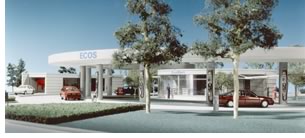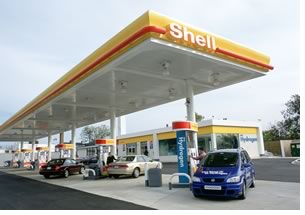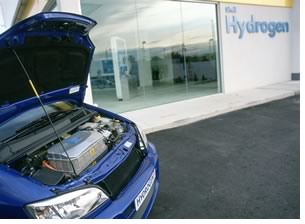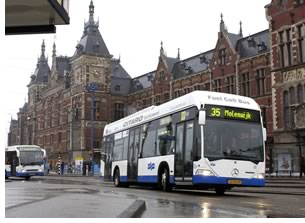

4/2006
Station prototype reinvents corner gas station

by Tracy Ostroff
 Alan Eliot Goldberg, FAIA, knows about fueling up. A design consultant
for Mobil Oil Corporation for about 25 years, he created a number of
gas station prototypes that affected tens of thousands of stations worldwide.
Now, after parting with the client on good terms, and with five grandchildren
in Los Angeles breathing California’s polluted air, the New Cannan,
Conn., architect is promoting hydrogen as a clean, safe, renewable energy
source. To that end, Goldberg assembled a partnership to design and build
a prototype Hydrogen Fueling Station/Information Center. “It’s
not a futuristic station. They can be built today,” Goldberg says.
The ARRC/H2 alliance, which launched in March at the Center for Architecture
in New York City, includes Goldberg’s firm AG/ENA along with Shell
Hydrogen, Hydrogenics, and other companies. The Information Center will
display a hydrogen car and exhibits to foster the public’s understanding
and acceptance of hydrogen fuels.
Alan Eliot Goldberg, FAIA, knows about fueling up. A design consultant
for Mobil Oil Corporation for about 25 years, he created a number of
gas station prototypes that affected tens of thousands of stations worldwide.
Now, after parting with the client on good terms, and with five grandchildren
in Los Angeles breathing California’s polluted air, the New Cannan,
Conn., architect is promoting hydrogen as a clean, safe, renewable energy
source. To that end, Goldberg assembled a partnership to design and build
a prototype Hydrogen Fueling Station/Information Center. “It’s
not a futuristic station. They can be built today,” Goldberg says.
The ARRC/H2 alliance, which launched in March at the Center for Architecture
in New York City, includes Goldberg’s firm AG/ENA along with Shell
Hydrogen, Hydrogenics, and other companies. The Information Center will
display a hydrogen car and exhibits to foster the public’s understanding
and acceptance of hydrogen fuels.
Goldberg based the radial design on AG/ENA’s Advance Refueling Retail Center. “There are some who think a hydrogen station should look like a gas station and it can. I don’t agree. Hydrogen is a new source of energy, and hydrogen cars use new technologies, so it is appropriate that the station be innovative as well,” says Goldberg of the copyrighted design that he says also solves many of the problems with traditional stations.
 The architect notes that the service station is among the most ubiquitous
elements of public life, with a substantial impact on towns and cities. “Yet
there has been virtually no change in its layout in more than 60 years
. . . only the technology and the graphics have improved,” Goldberg
says. “The
radial hydrogen station design responds to customer demands and the public’s
growing concerns for its communities and the environment. We broke with
traditional service station design by developing a radial layout that
has many innovative features and advantages over conventional designs.
For example, it provides a consumer-friendly environment, a simplified
system of entry/exit and internal circulation, more easily accessible
dispensers for faster refueling, and much more.”
The architect notes that the service station is among the most ubiquitous
elements of public life, with a substantial impact on towns and cities. “Yet
there has been virtually no change in its layout in more than 60 years
. . . only the technology and the graphics have improved,” Goldberg
says. “The
radial hydrogen station design responds to customer demands and the public’s
growing concerns for its communities and the environment. We broke with
traditional service station design by developing a radial layout that
has many innovative features and advantages over conventional designs.
For example, it provides a consumer-friendly environment, a simplified
system of entry/exit and internal circulation, more easily accessible
dispensers for faster refueling, and much more.”
“Green station”
The hydrogen fueling station design should not just dispense alternative
fuels, Goldberg says. “It should be a ‘green station’ in
every respect.” Some of these design elements include:
- Environmentally sustainable construction using recycled materials, water and energy efficiencies, reduced site disturbance, and other sustainable features
- A solar-electric system to supplement the station’s electric supply; they’re looking at lightweight solar panels built into membrane roofing and that would not have to be tilted
- Fully automated irrigation systems for the landscaped areas, which themselves would include native plantings
- A multi-dispenser, single-hose vapor recovery delivery system with a card reader for customers to “pay at the pump”
- Monitoring systems that assess business management, regulatory compliance, and environmental protection
- A carwash operation that is showcased through a glass wall, with automatic cleaning by a water-removing wiper system.
With half the station landscaped, it would not be an asphalt oasis but a park-like setting. A one-way traffic pattern makes for better pedestrian safety and easier vehicular access and egress, with a system of red and green signal lights that directs the customers to dispensers that are not in use or about to be vacant. The standard layout for both corner and mid-block construction would help keep engineering costs down. The single-entry design also guards against theft by “drive offs.” Another new feature is a remote electronic control system that simultaneously changes prices at the street and the fuel dispenser. The same technology could be used for merchandising displays.
 Hydrogen as a fuel source
Hydrogen as a fuel source
“There are many other technologies out there,” Goldberg says, “but
what makes hydrogen unique is that it is the only alternative fuel that
has the backing of a partnership of the federal government, about 30 states,
most of the car manufacturers, a few of the energy companies, and many
universities and researchers.” With that kind of support, Goldberg
decided to form a multi-company alliance that could “work on a project
to take the design we had for a gas station, which is not unlike a hydrogen
station, and develop, market, and build it.” That there aren’t
many hydrogen cars on the road does not prevent Goldberg and his team from
envisioning the future. The station would have an information center that
would display hydrogen cars, an exhibit on hydrogen works, and the benefits
of the clean energy source. “It would become a destination for communities
and school groups to visit the station.
“There have been tremendous advancements in a relatively short time,” Goldberg says. When the fuel-cell car was first developed some years ago, you couldn’t start it in cold weather and fuel-cell equipment and the electric motor left scant room for passengers. Now the systems “are almost miniscule.” The key, he says, is “getting them in the public’s hands and on the road, and then letting the development catch up, rather than wait until it’s perfect to introduce it. It has to be done now.
“While many people talk about it as a chicken-and-egg situation—you can’t have a hydrogen car without hydrogen stations and you can’t have stations without cars—that’s what our coalition is doing. We have, in addition to Shell Hydrogen, the endorsement of almost all the major car manufacturers who will supply cars for demonstration purposes. There’s an RFP coming out in a couple of weeks from California for three hydrogen stations. Part of that is the leasing of 12 hydrogen cars as a demonstration.”
The movement toward hydrogen is taking root in California, where officials have a roadmap they call the Hydrogen Highway, Goldberg notes. “These are existing freeways, but they have pinpointed where all the hydrogen stations will be located. In fact, Honda is developing software for the hydrogen car that will allow the driver to locate hydrogen stations.”
 Fringe benefits
Fringe benefits
The architect notes the interesting side effects of the technology. “A
car sits for 90 percent of the time in your driveway or in a parking
lot. If you think of it as a large battery run by a fuel cell when it’s
not being used, it could heat your home, provide the electricity for
your house, and even give energy back into the electric grid,” he
says. “This sounds futuristic, but Honda has already developed
and is testing equipment to do this. It’s not very bulky—it’s
not larger than your home furnace. They want the hydrogen car to have
other advantages than just being clean and having good mileage.”
Even though there is enough hydrogen being made in the U.S. today to serve a million cars, the political status quo makes any transition to alternative fuels difficult. “You have oil refineries, oil tankers, trucks, stations, so you have to make that a part of the hydrogen story, at least initially,” Goldberg says. He says what makes sense is the hydrogen station in Washington, D.C, which is a gas station with one island dedicated to hydrogen. “That makes sense and that’s the way it will happen initially.”
Goldberg says he hears people saying, “I want the environment to be better for my grandchildren. Well, it should be better for them as well. And we can do it now.” With the U.S. imbibing more fuel that it is finding, any problems with our traditional importing strategies could send oil prices soaring even higher. “I don’t mean to sound like an alarmist, but, on the other hand, it’s the reality,” Goldberg concludes. “Just read the paper and listen to the news, and put it all together. The time to act is now, when we have some time, rather than in desperation.”
Copyright 2006 The American Institute of Architects.
All rights reserved. Home Page ![]()
![]()
For more information on the ARRC/H2 Alliance visit the Web site.
![]()